 |
Watch live streaming nfl tv
 Watch live streaming nfl tv
Watch live streaming nfl tvNFL
United States
The National Football league called NFL.
Oakland Raiders vs Houston Texans
Match scheduled:
Last updated: 04-10-2009 from 17:00 until 20:30
21-09-2009 on 10:01
Week 4 :: NFL Regular Season 2009/2010

 |
A few months after the first AFL draft in 1959, the owners of the yet-unnamed Minneapolis expansion team accepted an offer to join the established National Football League as an expansion team (now called the Minnesota Vikings) in 1961, sending the AFL scrambling for a replacement.[4][5] At the time, Oakland seemed an unlikely venue for a professional football team. The city had not asked for a team, there was no ownership group and there was no stadium in Oakland suitable for pro football (the closest stadiums were in Berkeley and San Francisco) and there was already a successful NFL franchise in the Bay Area: the San Francisco 49ers. However, the AFL owners selected Oakland after Los Angeles Chargers owner Barron Hilton threatened to forfeit his franchise unless a second team was placed on the West Coast.[6] Accordingly, the city of Oakland was awarded the eighth AFL franchise on January 30, 1960, and the team inherited the Minneapolis club's draft picks.

 |
Upon receiving the franchise, Oakland civic leaders found a number of businesspeople willing to invest in the new team. A limited partnership was formed to own the team headed by managing general partner Y. Charles (Chet) Soda (1908-1989), a local real estate developer, and included general partners Ed McGah (1899-1983), Robert Osborne (1898-1968), F. Wayne Valley (1914-1986), restaurateur Harvey Binns (1914-1982), Don Blessing (1904-2000), and contractor Charles Harney (1902-1962)[7] as well as numerous limited partners. A "name the team" contest was held by a local newspaper, and the winner was the Oakland Señors. After a few weeks of being the butt of local jokes the fledgling team (and its owners) changed the team's name to the Oakland Raiders, which had finished third in the naming contest.[8] The original team colors were black, gold and white. The now-familiar team emblem of a pirate (or "raider") wearing a football helmet was created, reportedly a rendition of actor Randolph Scott.[9

 |
When the University of California, Berkeley refused to let the Raiders play home games at Memorial Stadium in Berkeley, they chose Kezar Stadium in San Francisco as their home field. The team's first regular season home game was played on September 11, 1960, a 37–22 loss to the Houston Oilers.[10] Raiders games were broadcast locally on KNBC (680 AM; the station later became KNBR), with Bud Foster handling play-by-play and Mel Venter providing color analysis.[11]

 |
When the Raider games were on KDIA (1310 AM) Bob Blum, did the play-by-play and Dan Galvin, did the color. In 1966, Bill King was hired for the play-by-play and Oakland Tribune sports writer, Scotty Sterling as color man.

 |
The Raiders were allowed to move to Candlestick Park for the final three home games of the 1960 season after gaining the approval of San Francisco's Recreation and Park Commission, marking the first time that professional football would be played at the new stadium.[12] The change of venue failed to attract larger crowds for the Raiders, with announced attendance of 12,061 (vs. the Chargers in a 41–17 loss on December 4), 9,037 (vs. the New York Titans in a 31–28 loss on December 11) and 7,000 (estimated, vs. the Broncos in a 48–10 victory to close out the season on December 17) at Candlestick

 |
.
The Raiders finished their first campaign with a 6–8 record, and lost $500,000. Desperately in need of money to continue running the team, Valley received a $400,000 loan from Buffalo Bills founder Ralph C. Wilson Jr.[13]

 |
After the conclusion of the first season Soda dropped out of the partnership, and on January 17, 1961, Valley, McGah and Osborne bought out the remaining four general partners. Soon after, Valley and McGah purchased Osborne's interest, with Valley named as the managing general partner. After splitting the previous home season between Kezar and Candlestick, the Raiders moved exclusively to Candlestick Park in 1961, where total attendance for the season was about 50,000, and finished 2–12. Valley threatened to move the Raiders out of the area unless a stadium was built in Oakland, but in 1962 the Raiders moved into 18,000-seat Frank Youell Field (later expanded to 22,000 seats), their first home in Oakland.[14] It was a temporary home for the team while the Oakland-Alameda County Coliseum was under construction. Under Marty Feldman and Red Conkright—the team's second and third head coaches since entering the AFL—the Raiders finished 1–13 in 1962, losing their first 13 games (and making for a 19–game losing streak from 1961 and 1962) before winning the season finale, and attendance remained low.

 |
[edit] Al Davis comes to Oakland (1963–1981)
After the 1962 season, Valley hired Al Davis, a former assistant coach for the San Diego Chargers, as head coach and general manager. At 33, he was the youngest person in professional football history to hold the positions.[15] Davis immediately changed the team colors to silver and black (he was reportedly inspired by the Army football black and gray uniforms), and began to implement what he termed the "vertical game," an aggressive offensive strategy based on the West Coast offense developed by Chargers head coach Sid Gillman.[16] Under Davis the Raiders improved to 10–4, and he was named the AFL's Coach of the Year in 1963. Though the team slipped to 5–7–2 in 1964, it rebounded to an 8–5–1 record in 1965.

 |
In April 1966, Davis left the Raiders after being named AFL Commissioner. Two months later, the league announced its merger with the NFL. With the merger, the position of commissioner was no longer needed, and Davis entered into discussions with Valley about returning to the Raiders. On July 25, 1966, Davis returned as part owner of the team. He purchased a 10 percent interest in the team for US $18,000, and became the team's third general partner and head of football operations.[17][18]

 |
On the field, the team Davis had assembled and coached steadily improved. With John Rauch (Davis's hand-picked successor) as head coach, the Raiders won the 1967 AFL Championship, defeating the Houston Oilers 40–7. The win earned the team a trip to Super Bowl II, where they were beaten 33–14 by Vince Lombardi's Green Bay Packers. The following two years, the Raiders again won Western Division titles, only to lose the AFL Championship to the eventual Super Bowl winners—the New York Jets (1968) and Kansas City Chiefs (1969). In 1970, the AFL–NFL merger took place and the Raiders joined the Western Division of the American Football Conference in the newly merged NFL.

 |
In 1969, John Madden became the team's sixth head coach, and under him the Raiders became one of the most successful franchises in the NFL, winning six division titles during the 1970s. The achievement was marred somewhat by three consecutive losses in AFC Championships from 1973 to 1975, two against the Pittsburgh Steelers. Then, after finishing 13–1 in 1976, the Raiders defeated the Steelers 24–7 in the AFC Championship game. Oakland then defeated the Minnesota Vikings, 32–14, in Super Bowl XI for the franchise's first NFL championship.

 |
In 1972, with Wayne Valley out of the country for several weeks attending the Olympic Games in Munich, Davis's attorneys drafted a revised partnership agreement that gave him total control over all of the Raiders' operations. McGah, a supporter of Davis, signed the agreement. Under partnership law, by a 2–1 vote of the general partners, the new agreement was thus ratified. Valley was furious when he discovered this, and immediately filed suit to have the new agreement overturned, but the court sided with Davis and McGah. In January 1976, Valley sold his interest in the team, and Davis — who now owned only 25 percent of the Raiders — was firmly in charge.[17][19]

 |
After ten consecutive winning seasons and one Super Bowl championship, Madden left the Raiders (and coaching) in 1979 to pursue a career as a television football commentator. His replacement was former Raiders quarterback Tom Flores, the first Hispanic head coach in NFL history.[20] In the fifth week of the 1980 season, starting quarterback Dan Pastorini broke his leg and was replaced by former number-one draft pick Jim Plunkett. Plunkett led Oakland to an 11–5 record and a wild card berth. After playoff victories against the Houston Oilers, Cleveland Browns, and San Diego Chargers, the Raiders clinched their second NFL championship in five years with a 27–10 win over the Philadelphia Eagles in Super Bowl XV. With the victory, the Raiders became the first ever wild card team to win a Super Bowl."[21] Two Super Bowl records of note occurred in this game: 1) Kenny King's 80-yard, first-quarter, catch-and-run reception from Jim Plunkett remained the longest touchdown Super Bowl pass play for the next 23 years; and 2) Rod Martin's three interceptions of Eagles' quarterback Ron Jaworski still stands today as a Super Bowl record.[22] Reflecting on the last ten years during the post-game awards ceremony, Al Davis stated "...this was our finest hour, this was the finest hour in the history of the Oakland Raiders. To Tom Flores, the coaches, and the athletes: you were magnificent out there, you really were." [23]

 |
[edit] Move to Los Angeles (1982–1994)
Before the 1980 season, Al Davis attempted unsuccessfully to have improvements made to Oakland Coliseum, specifically the addition of luxury boxes. That year, he signed a Memorandum of Agreement to move the Raiders from Oakland to Los Angeles. The move, which required three-fourths approval by league owners, was defeated 22–0 (with five owners abstaining). When Davis tried to move the team anyway, he was blocked by an injunction. In response, the Raiders not only became an active partner in an antitrust lawsuit filed by the Los Angeles Memorial Coliseum (who had recently lost the Los Angeles Rams), but filed an antitrust lawsuit of their own.[24] After the first case was declared a mistrial, in May 1982 a second jury found in favor of Davis and the Los Angeles Coliseum, clearing the way for the move.[25][26][27] With the ruling, the Raiders finally relocated to Los Angeles for the 1982 season to play their home games at the Los Angeles Coliseum.

 |
The team finished 8–1 in the strike-shortened 1982 season, first in the AFC, but lost in the second round of the playoffs to the New York Jets. The following season, the team finished 12–4 and won convincingly against the Steelers and Seattle Seahawks in the AFC playoffs. Against the Washington Redskins in Super Bowl XVIII, Los Angeles built a 21–3 halftime lead en route to a 38–9 victory and their third NFL championship. The next two seasons, the Raiders qualified for the playoffs but lost in the wild card round and the divisional round, respectively. From 1986 through 1989, Los Angeles finished no better than 8–8 and posted consecutive losing seasons for the first time since 1961–62. After finishing 5–10 in 1987, Tom Flores moved to the front office and was replaced by Denver Broncos offensive assistant coach Mike Shanahan.

 |
After starting the 1989 season with a 1–3 record, Davis fired Shanahan, which began a long-standing feud between the two.[28] He was replaced by former Raider offensive lineman Art Shell, who had been voted into the Pro Football Hall of Fame earlier in the year. With the hiring, Shell became the first African American head coach in the modern NFL era.[29] In 1990, Shell led Los Angeles to a 12–4 record and an appearance in the AFC Championship Game, where they lost a lopsided affair to the Buffalo Bills, 51–3

 |
.
The team's fortunes faded after the loss. They made two other playoff appearances during the 1990s, and finished higher than third place only three times. This period was marked by the career-ending injury of two-sport athlete Bo Jackson in 1990, the failure of troubled quarterback Todd Marinovich, the acrimonious departure of Marcus Allen in 1993, and the retirement of Hall of Fame defensive end Howie Long after the 1993 season. Shell was fired after posting a 9–7 record in the 1994 season.

 |
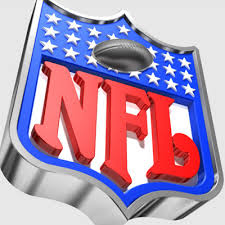 | 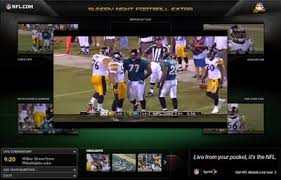 |  |  |  |

 |
Shell's five-plus-year tenure as head coach in Los Angeles was marked particularly by a bitter dispute between star running back Marcus Allen and Al Davis. The exact source of the friction is unknown, but a contract dispute led Davis to refer to Allen as "a cancer on the team."[30] By the late 1980s, injuries began to reduce Allen's role in the offense. This role was reduced further in 1987, when the Raiders drafted Bo Jackson—even though he originally decided to not play professional football in 1986 (when drafted by the Tampa Bay Buccaneers in the first round).[31] By 1990, Allen had dropped to fourth on the team's depth chart, leading to resentment on the part of his teammates. In late 1992 Allen lashed out publicly at Davis, and accused him of trying to ruin his career.[32][33] In 1993, Allen left to play for the rival Kansas City Chiefs.

 |
 |  |  |  |  |

 |
As early as 1987, Davis began to seek a new, more modern stadium away from the Coliseum and the dangerous neighborhood that surrounded it at the time (which caused the NFL to schedule the Raiders' Monday Night Football appearances as away games). In addition to sharing the venue with the USC football team, the Coliseum was aging and still lacked the luxury suites and other amenities that Davis was promised when he moved the Raiders to Los Angeles.[34] Numerous venues in California were considered, including one near Hollywood Park in Inglewood and another in Carson. In August 1987, it was announced that the city of Irwindale paid Davis USD $10 million as a good-faith deposit for a prospective stadium site.[35] When the bid failed, Davis kept the non-refundable deposit.[36][37]

 |
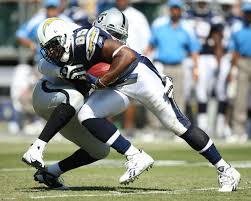 |  |  |  |  |

 |
 | 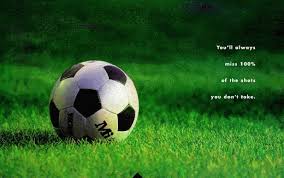 |  | 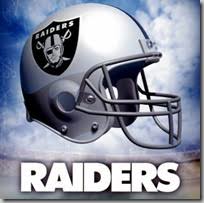 |  |












